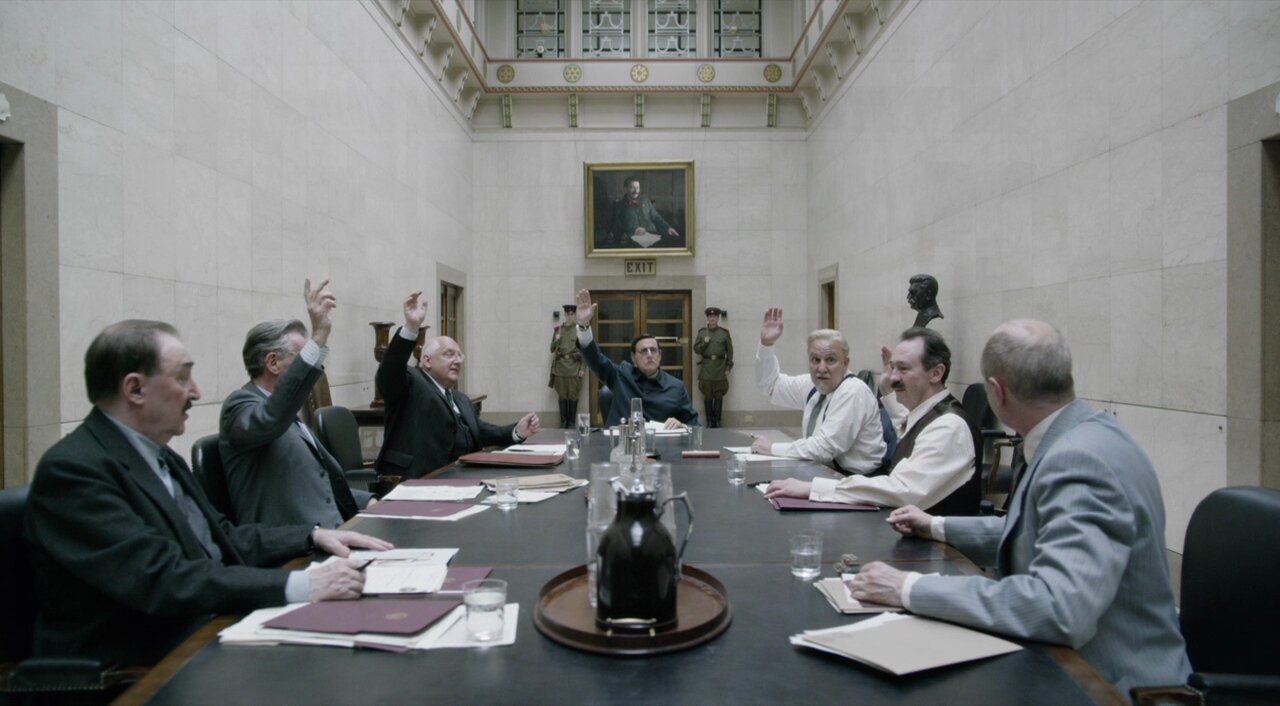The Death of Stalin (dir. Armando Ianucci, 2017) - Review
Download The Death of Stalin screenplay for personal, private use.
The Death of Stalin offers both a moralising depiction of ‘then’ - the whirlwind of chaos that unfolded around the demise of one man in 1953 - and a cautionary political tale about ‘now’ - a portrait of the present-day cult of personality-cum-premiership. Much of the film’s wit and fascination stems from the fact that it offers no definitive statement as to how the audience should interpret its satire. Iannucci's latest film functions as a fable about the paradoxical human frailty of large historical figures, and as an ostensibly historical tale that is strikingly contemporary.
Adapted from Fabien Nury and Thierry Robin's graphic novel, The Death of Stalin condenses ten months of history into a week of terror and farce. March 1953, Josef Stalin (Adrian McLoughlin) suffers a stroke while taking in a piece of hate mail from concert pianist Maria Yudina (Olga Kurylenko), sparking a power struggle among his inner circle. Forerunners Nikita Khrushchev (Steve Buscemi) and secret police chief Lavrentiy Beria (Simon Russell Beale) square off against Foreign Minister Vyacheslav Molotov (Michael Palin) and Stalin's hapless deputy Georgy Malenkov (Jeffrey Tambor). Khrushchev ultimately triumphs with the help of World War II hero Marshal Georgy Zhukov (Jason Isaacs), who orchestrates Beria's show trial and execution, allowing Khrushchev to assume Stalin's place as ruler of the USSR.
The film's opening shot - a close-up of Maria's hands playing piano keys - announces the film’s interest in a universal human trait (the will to do and say whatever is required in a high-pressure professional situation) and sets a specific political and cultural scene (the moral and logistical complexities of life in the court of a mercurial ruler). The opening moments further chime with a sense that the main characters' political beliefs are performed in public for practical reasons. This establishes the film as a comic critique of bad faith and bad judgement, a study of the individuals and decisions that condemned the Soviet Union to a mid-century state of rolling paranoid purges. To underscore the theme further, self-interest the film's concern with humankind's tendency toward that same characteristic; Malenkov complains that he "can't remember who's alive and who's dead.”
A major question for Iannucci and his audience relates to the ethical standing of the laughter provoked by its depiction of Stalinist atrocity. Jokes come not only from his trademark profane wisecrackers (“out of my way, you fannies”, “you’re not even a person, you’re a testicle”) and slapstick humour, but also from ridicule of the bureaucratic cowardice of the Soviet ruling class. One particularly memorable scene depicts the Council putting their hands up and down nervously to carry a vote ‘unanimously’ only when they are sure their allies will support them. The Death of Stalin allows viewers the scope to make clear forms of moral and emotional distinction among the members of Stalin's inner circle. Some (Beria, primarily) are shown to cause fear; others (most obviously, Khrushchev) are generally shown as cowardly.
Tackling a serious topic requires prior willingness to not take it seriously; to reveal or change the face of something one must first be able to laugh in its face. Most obviously of all, The Death of Stalin accedes to this idea of satire in its employment of a circular narrative form: for all the conspiracy and carnage on display, the film and its characters end up back where they started. The story concludes in the same Moscow concert hall where it commenced, as Leonid Brezhnev lurks over Khrushchev's shoulder, patiently awaiting his opportunity. This structure makes the mocking suggestion that powerful men never prove quite as powerful or frightening as they might like to think.
Áine Kennedy is a London-based writer and manager of the ScriptUp blog.





